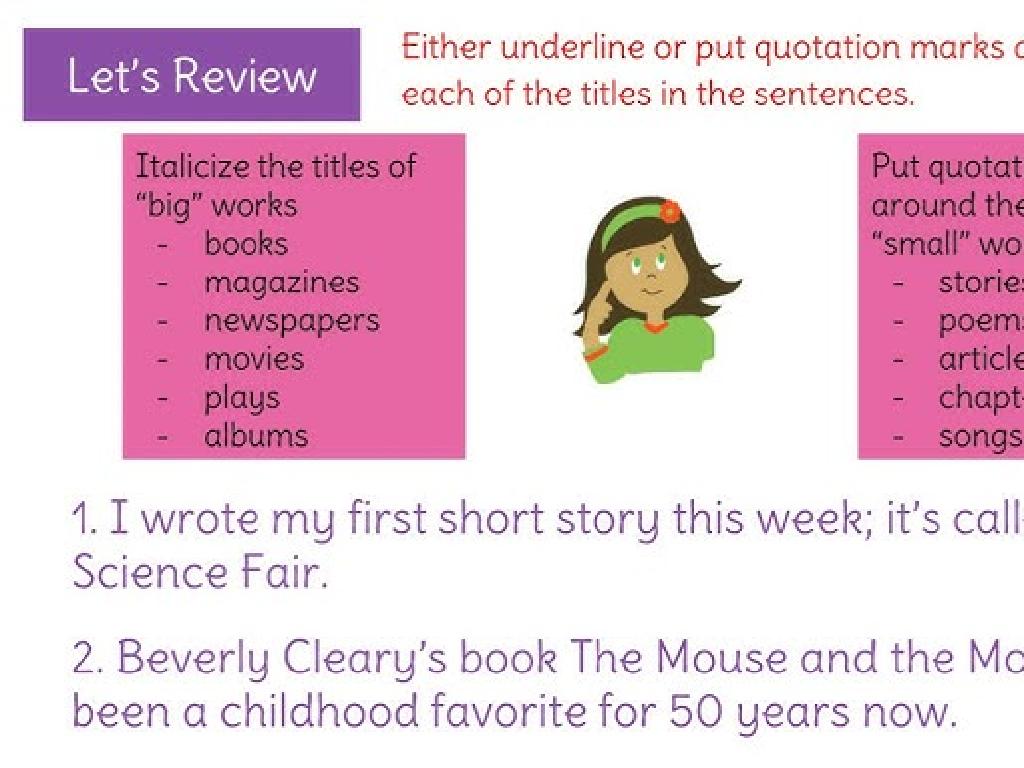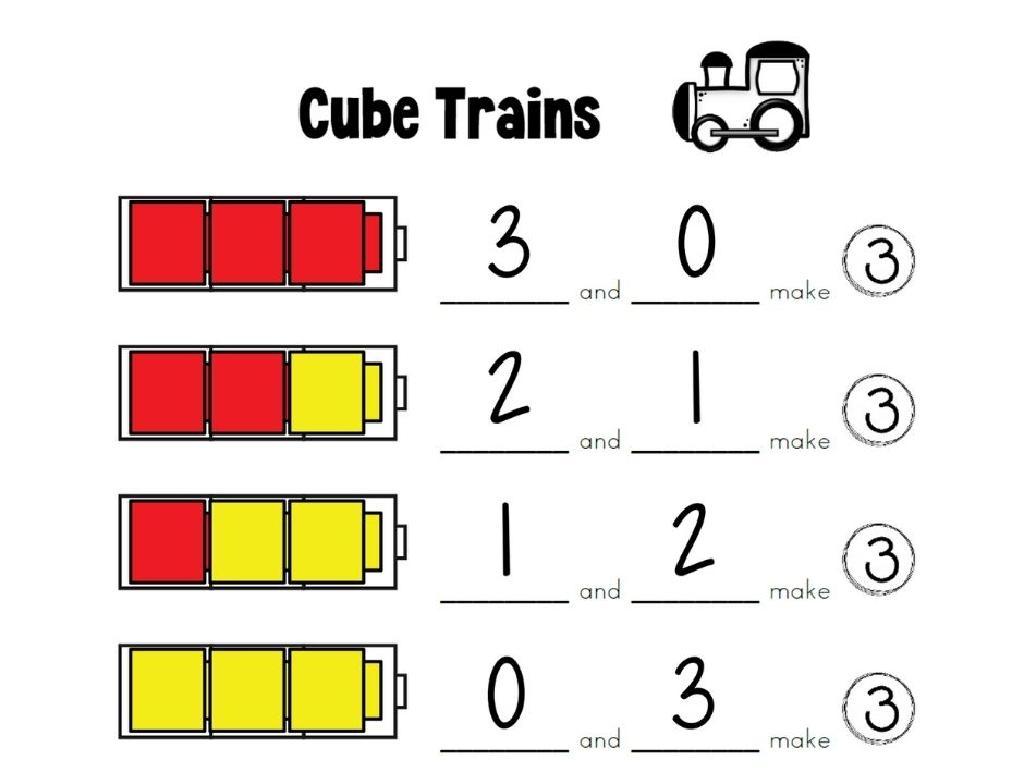Literary Devices
Subject: Language arts
Grade: Third grade
Topic: Sensory Details
Please LOG IN to download the presentation. Access is available to registered users only.
View More Content
Welcome to Sensory Details!
– What are sensory details?
– Descriptions that appeal to our senses
– Experiencing the world
– We use our 5 senses to understand the world
– Senses in stories
– Writers use sensory details to enhance the reader’s experience
– Making stories come alive
– Vivid details make stories more engaging and real
|
This slide introduces the concept of sensory details, which are descriptive elements in writing that appeal to the five senses: sight, sound, smell, taste, and touch. Explain to students how we use our senses to experience the world around us. Discuss how authors use these details to make stories more vivid and engaging, allowing readers to feel like they are part of the story. Encourage students to think of their favorite books and the sensory descriptions that made those stories come alive for them. This will set the foundation for them to use sensory details in their own writing.
Exploring Our Five Senses in Stories
– Discover the five senses
– Sight, sound, smell, taste, touch
– Examples of each sense
– Sight: bright colors, Sound: loud bang, Smell: fresh bread, Taste: sweet candy, Touch: soft fur
– Senses bring stories to life
– Descriptions using senses make stories vivid
– How senses improve story understanding
– Using senses helps us feel part of the story
|
This slide introduces students to the concept of sensory details in literature, focusing on the five senses: sight, sound, smell, taste, and touch. Provide examples for each sense and explain how they contribute to creating a rich image in the reader’s mind. Discuss how sensory details can enhance the experience of reading by making the scenes and characters more real and relatable. Encourage students to think of their favorite stories and the sensory descriptions that made those stories memorable. This will help them understand the importance of sensory details in storytelling and how they can use them in their own writing.
Sensory Details in Stories
– Identify sensory details in text
– Look for words that describe sights, sounds, smells, tastes, and textures
– Understand how details paint pictures
– Sensory details help us visualize the story’s events and settings
– Read a paragraph as a class
– We’ll read aloud together and listen for descriptive words
– Find and discuss sensory words
– Pick out words that appeal to our senses and share with the class
|
This slide is aimed at helping students recognize and understand the importance of sensory details in literature. By identifying words that describe the five senses, students learn how authors create vivid imagery to enhance the reader’s experience. During the class activity, select a paragraph from a story that is rich in sensory language. Read it together with the class, then have students identify and discuss the sensory words they heard. Encourage them to explain how these words help them ‘see’ and experience the story. This interactive approach will help solidify their understanding of sensory details and their effect on storytelling.
Show, Don’t Tell with Sensory Details
– ‘Showing’ vs. ‘Telling’: What’s the difference?
– ‘Telling’ just states facts; ‘showing’ creates a picture in the reader’s mind.
– Turn ‘telling’ into ‘showing’
– Change ‘The sun set’ to ‘The sky blazed with orange and pink as the sun dipped below the horizon.’
– Use your senses to add details
– Describe how things look, sound, smell, taste, and feel.
– Examples of ‘show, don’t tell’
– ‘The cake was good’ becomes ‘The cake tasted like a sweet cloud of vanilla and sugar.’
|
This slide introduces the concept of ‘show, don’t tell,’ a key literary device in writing. ‘Telling’ simply informs the reader, while ‘showing’ uses sensory details to create a vivid picture. Encourage students to rewrite bland sentences by including sights, sounds, smells, tastes, and textures. Provide clear examples to illustrate the difference. For instance, instead of saying ‘The dog is happy,’ show it with ‘The dog wagged its tail and barked with joy.’ This exercise helps students enhance their descriptive writing skills and makes their stories more engaging.
Crafting Sentences with Sensory Details
– Create sentences with sensory details
– Use the five senses to describe a scene
– Share your sensory sentences
– Tell the class what you’ve written
– Discuss sentence enhancements
– How do sensory details make it better?
– Understand the impact of sensory details
|
This slide is designed to engage students in an activity where they will use sensory details to enhance their writing. Encourage them to think about how each of the five senses can be incorporated into a sentence to make it more vivid and interesting. After writing, students will share their sentences with the class, fostering a collaborative learning environment. Lead a discussion on how sensory details improve writing, making it more engaging and helping the reader to visualize the scene. This activity will help students understand the importance of descriptive language in storytelling and other forms of writing.
Class Activity: Sensory Detail Hunt
– Pair up for a sensory detail search
– Find sensory details in the text
– Look for words that describe sights, sounds, smells, tastes, and touches
– Share your discoveries with the class
– Discuss the depth sensory details add
– How do these descriptions make the story feel more real?
|
In this interactive class activity, students will work in pairs to enhance their understanding of sensory details in literature. Provide a short story or a passage from a book that is rich in descriptive language. Instruct the pairs to highlight words or phrases that appeal to the five senses. After the hunt, each pair will present their findings, fostering public speaking and collaboration skills. Conclude the activity with a discussion on how sensory details help readers vividly imagine the scenes and emotions in the story, making the reading experience more engaging. For differentiation, consider providing varying levels of text complexity to accommodate all reading levels in the classroom.
Wrapping Up: Sensory Details
– Recap: What are sensory details?
– Sensory details help us see, hear, smell, taste, and touch in stories
– Why sensory details matter
– They make stories come alive and feel real
– Homework: Craft a descriptive paragraph
– Use the 5 senses to describe a favorite place or moment
– Bring your paragraph to the next class
– We’ll share and discuss our paragraphs together!
|
As we conclude today’s lesson, remind students that sensory details are the spices that make a story delicious. They allow readers to experience the story as if they were part of it. For homework, students should write a short paragraph describing a scene or object using words related to the five senses. Encourage creativity and the use of vivid language. In the next class, we will share these paragraphs to appreciate how sensory details enhance writing. This exercise will help students understand the importance of sensory details and improve their descriptive writing skills.






